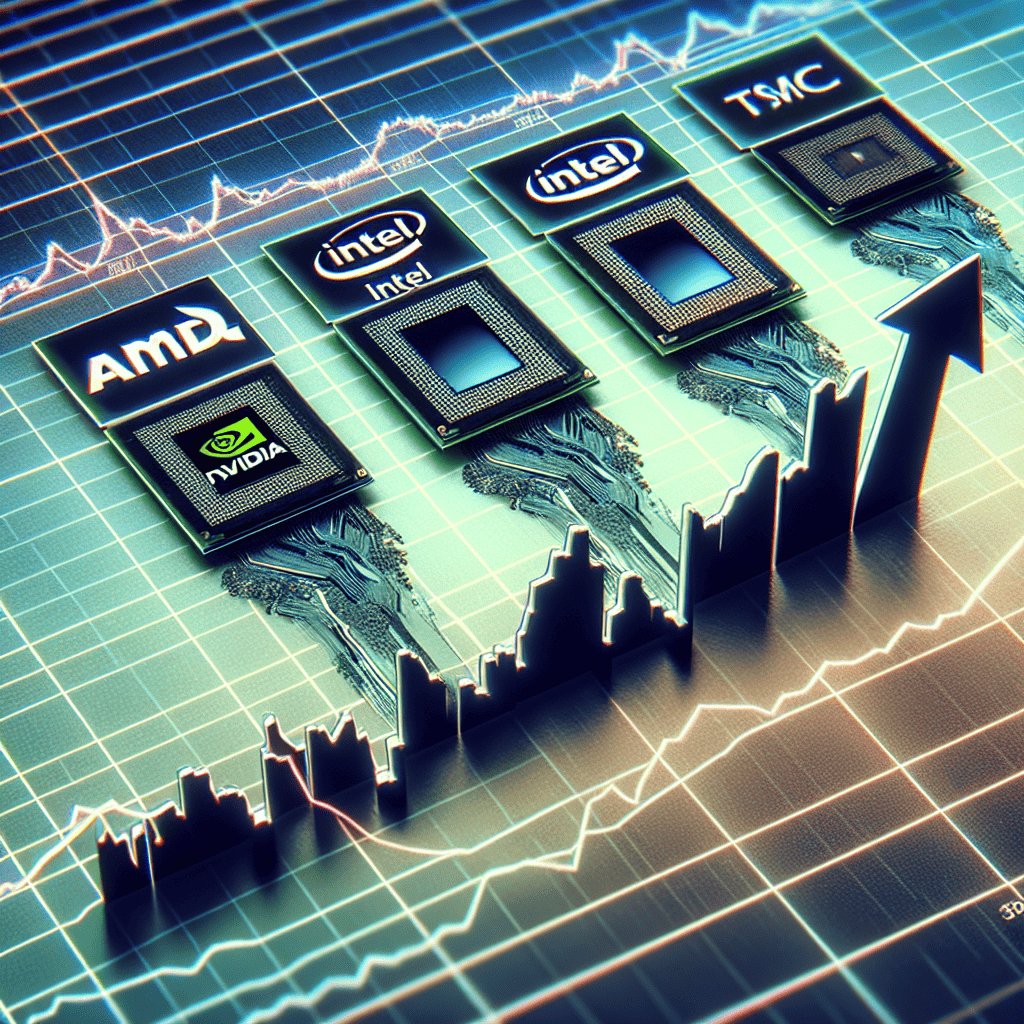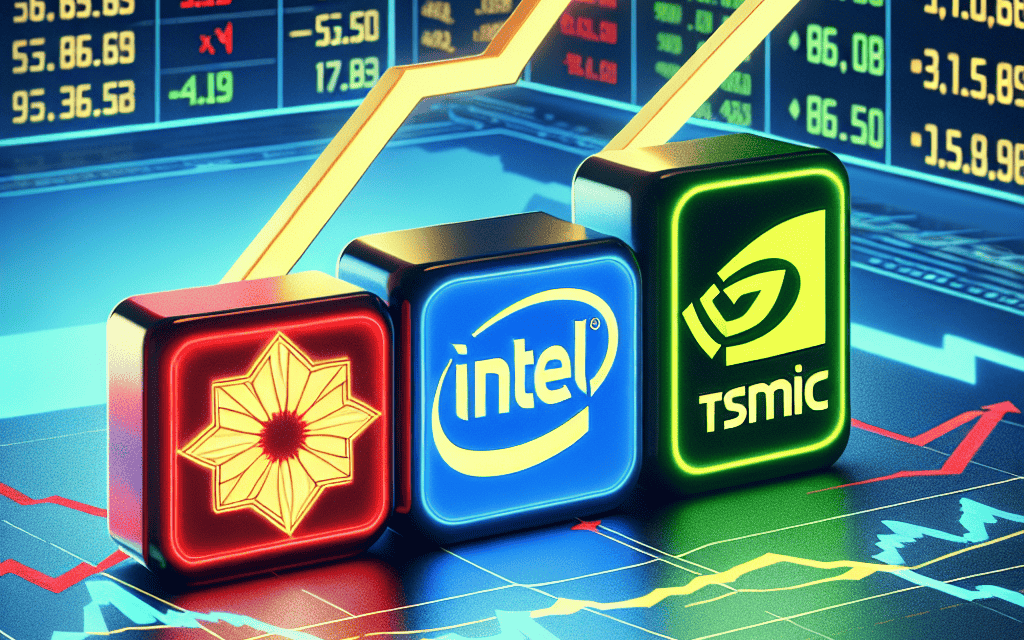“Chasing the Titan: Can AMD, Intel, and TSMC Catch Nvidia’s Market Wave?”
Introduction
In recent years, Nvidia has experienced a remarkable surge in the market, driven by its dominance in the graphics processing unit (GPU) sector and its strategic expansion into artificial intelligence (AI) and data center technologies. This growth has positioned Nvidia as a formidable player in the semiconductor industry, challenging its competitors to keep pace. As AMD, Intel, and TSMC navigate this competitive landscape, they face the pressing question of whether they can match Nvidia’s market momentum. Each company brings its unique strengths and strategies to the table: AMD with its innovative CPU and GPU offerings, Intel with its expansive reach and diversification into AI and data-centric solutions, and TSMC as a leading semiconductor manufacturer with cutting-edge fabrication capabilities. The interplay of these industry giants will shape the future of the semiconductor market, as they strive to capture market share and drive technological advancements in an era defined by rapid innovation and increasing demand for high-performance computing solutions.
Analyzing AMD’s Strategic Moves to Compete with Nvidia’s Market Dominance
In recent years, Nvidia has established itself as a dominant force in the semiconductor industry, particularly in the realm of graphics processing units (GPUs). This dominance has been driven by Nvidia’s innovative technologies and strategic market positioning, which have allowed it to capture a significant share of the burgeoning artificial intelligence (AI) and gaming markets. As Nvidia continues to surge ahead, competitors such as AMD, Intel, and TSMC are strategizing to close the gap and potentially challenge Nvidia’s supremacy. Among these competitors, AMD has been particularly proactive in its efforts to enhance its market position and compete more effectively with Nvidia.
AMD’s strategic moves have been multifaceted, focusing on both technological advancements and strategic partnerships. One of the key areas where AMD has made significant strides is in the development of its Radeon GPU line. By leveraging its expertise in high-performance computing, AMD has been able to produce GPUs that offer competitive performance at various price points. This has allowed AMD to appeal to a broad range of consumers, from budget-conscious gamers to professional content creators. Furthermore, AMD’s commitment to open-source software development, exemplified by its ROCm platform, has fostered a supportive ecosystem that encourages innovation and collaboration.
In addition to its technological advancements, AMD has also pursued strategic partnerships to bolster its competitive position. Collaborations with major technology companies have enabled AMD to integrate its GPUs into a wider array of products, thereby increasing its market reach. For instance, AMD’s partnership with Microsoft to supply custom GPUs for the Xbox Series X has not only provided a significant revenue stream but also enhanced AMD’s visibility in the gaming sector. Similarly, AMD’s collaboration with Google to power its cloud gaming service, Stadia, underscores the company’s commitment to expanding its presence in emerging markets.
While AMD’s efforts have been commendable, the company faces significant challenges in its quest to match Nvidia’s market surge. One of the primary obstacles is Nvidia’s stronghold in the AI sector, where its CUDA platform has become the industry standard for AI development. To counter this, AMD has been investing in its own AI capabilities, including the development of its MI100 and MI200 series accelerators. These products are designed to deliver high-performance computing solutions for AI workloads, positioning AMD as a viable alternative to Nvidia in this critical market segment.
Moreover, AMD’s competition with Nvidia is not occurring in isolation. Intel and TSMC are also key players in the semiconductor industry, each with its own strategies to capture market share. Intel, for instance, has been making significant investments in its GPU division, with the launch of its Xe graphics architecture aimed at challenging both Nvidia and AMD. Meanwhile, TSMC, as a leading semiconductor manufacturer, plays a crucial role in the supply chain for both AMD and Nvidia, highlighting the interconnected nature of the industry.
In conclusion, while AMD has made significant progress in its efforts to compete with Nvidia, the path to matching Nvidia’s market surge is fraught with challenges. Through a combination of technological innovation, strategic partnerships, and a focus on emerging markets, AMD is positioning itself as a formidable competitor. However, the dynamic nature of the semiconductor industry, coupled with the competitive strategies of other key players like Intel and TSMC, means that the landscape is continually evolving. As such, AMD’s ability to adapt and innovate will be critical in determining its success in this highly competitive arena.
Intel’s Innovations: Can They Rival Nvidia’s Technological Advancements?
In the rapidly evolving landscape of semiconductor technology, the competition among industry giants such as AMD, Intel, TSMC, and Nvidia is intensifying. Nvidia, known for its cutting-edge graphics processing units (GPUs), has recently experienced a significant market surge, driven by advancements in artificial intelligence (AI) and machine learning applications. This raises the question of whether Intel, with its own innovations, can rival Nvidia’s technological advancements and capture a larger share of the market.
Intel, a stalwart in the semiconductor industry, has been making strategic moves to enhance its product offerings and regain its competitive edge. The company has been investing heavily in research and development to innovate and expand its portfolio beyond traditional central processing units (CPUs). One of Intel’s key strategies is its focus on integrated graphics solutions, which aim to provide a seamless experience for users who require both processing power and graphical capabilities. By integrating graphics into its CPUs, Intel seeks to offer a compelling alternative to discrete GPUs, which have been Nvidia’s stronghold.
Moreover, Intel’s foray into the discrete GPU market with its Intel Arc series marks a significant step in its efforts to challenge Nvidia’s dominance. The Arc GPUs are designed to cater to a wide range of applications, from gaming to professional workloads, and are expected to leverage Intel’s expertise in manufacturing and design. This move not only diversifies Intel’s product lineup but also positions the company to compete more directly with Nvidia in the graphics domain.
In addition to hardware innovations, Intel is also focusing on software advancements to enhance its competitive position. The company’s emphasis on AI and machine learning is evident in its development of oneAPI, a unified programming model that aims to simplify the development of applications across diverse computing architectures. By providing a common framework for developers, Intel hopes to foster innovation and drive the adoption of its technologies in AI-driven applications, an area where Nvidia has traditionally excelled.
Furthermore, Intel’s strategic partnerships and acquisitions play a crucial role in its quest to rival Nvidia. Collaborations with companies in the AI and data center sectors enable Intel to integrate cutting-edge technologies into its offerings, thereby enhancing its value proposition. Acquisitions of firms specializing in AI and machine learning further bolster Intel’s capabilities, allowing it to tap into new markets and expand its influence.
While Intel’s innovations are promising, the challenge of matching Nvidia’s market surge is formidable. Nvidia’s stronghold in the GPU market is underpinned by its robust ecosystem, which includes a wide range of software tools and libraries optimized for AI and machine learning. This ecosystem has fostered a loyal developer community, making it difficult for competitors to lure users away. Additionally, Nvidia’s strategic focus on AI and data center solutions has positioned it as a leader in these high-growth areas, further solidifying its market position.
In conclusion, while Intel is making significant strides in innovation and diversification, the task of rivaling Nvidia’s technological advancements is complex and multifaceted. Intel’s success will depend on its ability to execute its strategies effectively, capitalize on emerging opportunities, and continue to invest in research and development. As the semiconductor industry continues to evolve, the competition between these tech giants will undoubtedly shape the future of computing, with each company striving to outpace the other in the race for technological supremacy.
TSMC’s Role in the Semiconductor Industry: A Potential Threat to Nvidia?
In the rapidly evolving landscape of the semiconductor industry, Taiwan Semiconductor Manufacturing Company (TSMC) has emerged as a pivotal player, wielding significant influence over the global market. As the world’s largest contract chip manufacturer, TSMC’s role is indispensable, not only for its technological prowess but also for its strategic partnerships with major industry players like AMD and Intel. This raises an intriguing question: could TSMC’s dominance pose a potential threat to Nvidia’s recent market surge?
To understand this dynamic, it is essential to consider TSMC’s unique position in the semiconductor supply chain. Unlike Nvidia, which designs its own graphics processing units (GPUs), TSMC specializes in manufacturing chips for a variety of clients. This business model allows TSMC to leverage economies of scale and invest heavily in cutting-edge technologies, such as advanced process nodes and 3D chip stacking. Consequently, TSMC’s technological advancements have become a cornerstone for companies like AMD and Intel, enabling them to compete more effectively against Nvidia.
Moreover, TSMC’s collaboration with AMD has been particularly fruitful. AMD’s Ryzen processors and Radeon GPUs, manufactured by TSMC, have gained significant traction in the market, challenging Nvidia’s dominance in the GPU sector. The synergy between AMD’s innovative designs and TSMC’s manufacturing capabilities has resulted in products that offer competitive performance and value. This partnership exemplifies how TSMC’s role as a manufacturing powerhouse can indirectly influence market dynamics, potentially curbing Nvidia’s growth trajectory.
In addition to AMD, Intel has also turned to TSMC to bolster its manufacturing capabilities. Historically, Intel has been known for its integrated device manufacturing model, where it designs and manufactures its own chips. However, facing production challenges and delays in its own facilities, Intel has increasingly relied on TSMC to produce some of its products. This strategic shift not only underscores TSMC’s critical role in the industry but also highlights the potential for Intel to regain its competitive edge against Nvidia.
Furthermore, TSMC’s commitment to innovation and capacity expansion positions it as a formidable force in the semiconductor industry. The company’s substantial investments in research and development, coupled with its plans to build new fabrication plants, ensure that it remains at the forefront of technological advancements. This continuous evolution enables TSMC to meet the growing demand for semiconductors across various sectors, including artificial intelligence, automotive, and consumer electronics, where Nvidia has traditionally held a strong presence.
However, it is important to note that while TSMC’s influence is significant, it does not directly compete with Nvidia. Instead, TSMC’s role is more of an enabler, providing the necessary infrastructure for companies like AMD and Intel to challenge Nvidia’s market position. In this context, TSMC’s impact on Nvidia is indirect, yet profound, as it empowers Nvidia’s competitors to innovate and capture market share.
In conclusion, TSMC’s role in the semiconductor industry is undeniably crucial, serving as a catalyst for competition and innovation. While it does not pose a direct threat to Nvidia, its partnerships with AMD and Intel have the potential to alter the competitive landscape. As TSMC continues to advance its manufacturing capabilities, it will be interesting to observe how this influences the strategies of major players like Nvidia, AMD, and Intel, ultimately shaping the future of the semiconductor industry.
Market Trends: How AMD, Intel, and TSMC Are Responding to Nvidia’s Growth

In recent years, Nvidia has experienced a remarkable surge in the market, driven by its dominance in the graphics processing unit (GPU) sector and its strategic expansion into artificial intelligence (AI) and data center technologies. This growth has not gone unnoticed by industry giants such as AMD, Intel, and TSMC, who are now strategizing to capture a share of the burgeoning market. As Nvidia continues to set the pace, these companies are exploring various avenues to enhance their competitive edge and capitalize on emerging opportunities.
AMD, known for its innovative approach in the semiconductor industry, has been making significant strides to challenge Nvidia’s supremacy. By focusing on high-performance computing and gaming, AMD has successfully launched its Radeon RX series, which competes directly with Nvidia’s GeForce lineup. Moreover, AMD’s acquisition of Xilinx, a leader in adaptive computing, underscores its commitment to diversifying its portfolio and strengthening its position in the AI and data center markets. This strategic move not only broadens AMD’s technological capabilities but also enhances its ability to offer comprehensive solutions that rival Nvidia’s offerings.
Meanwhile, Intel, a stalwart in the semiconductor industry, is also making concerted efforts to regain its footing in the GPU market. With the introduction of its Xe graphics architecture, Intel aims to provide a viable alternative to Nvidia’s GPUs, targeting both consumer and enterprise segments. Furthermore, Intel’s investment in AI and machine learning technologies is indicative of its intent to compete in the data center space, where Nvidia has established a stronghold. By leveraging its extensive resources and expertise, Intel is positioning itself to capture a significant share of the market, although it faces the challenge of overcoming Nvidia’s established brand loyalty and technological advancements.
In parallel, TSMC, the world’s largest contract chipmaker, plays a crucial role in the semiconductor ecosystem, supplying advanced chips to both AMD and Nvidia. As Nvidia’s growth continues to drive demand for cutting-edge semiconductor technology, TSMC is expanding its manufacturing capabilities to meet this demand. The company’s investment in advanced process nodes, such as 5nm and 3nm technologies, ensures that it remains at the forefront of innovation, providing its clients with the necessary tools to compete effectively. TSMC’s strategic partnerships and collaborations further solidify its position as a key enabler in the industry, supporting the ambitions of both AMD and Intel as they vie for market share.
As these companies navigate the competitive landscape, it is evident that their strategies are not solely focused on matching Nvidia’s current offerings but also on anticipating future trends and technological advancements. The rapid evolution of AI, machine learning, and data analytics presents a myriad of opportunities for growth, and AMD, Intel, and TSMC are keenly aware of the need to innovate continuously. By investing in research and development, forging strategic alliances, and expanding their product portfolios, these companies are positioning themselves to not only challenge Nvidia’s dominance but also to shape the future of the semiconductor industry.
In conclusion, while Nvidia’s market surge presents a formidable challenge, AMD, Intel, and TSMC are actively responding with strategic initiatives aimed at capturing a share of the expanding market. Through innovation, collaboration, and a keen focus on emerging technologies, these companies are poised to make significant inroads, ensuring that the competition remains dynamic and that the industry continues to thrive. As the market evolves, the interplay between these industry leaders will undoubtedly shape the trajectory of technological advancement and market dynamics in the years to come.
The Future of Graphics Processing: AMD, Intel, and TSMC’s Plans to Challenge Nvidia
In recent years, Nvidia has established itself as a dominant force in the graphics processing unit (GPU) market, driven by its innovative technologies and strategic positioning in the burgeoning fields of artificial intelligence (AI) and gaming. As Nvidia continues to surge ahead, competitors such as AMD, Intel, and TSMC are strategizing to challenge its supremacy. These companies are leveraging their unique strengths and resources to capture a larger share of the GPU market, which is expected to grow significantly in the coming years.
AMD, known for its competitive pricing and high-performance products, has been a formidable player in the GPU market. The company has made significant strides with its Radeon series, which has gained traction among gamers and professionals alike. AMD’s strategy involves focusing on both the gaming and data center markets, where it aims to provide cost-effective solutions without compromising on performance. By leveraging its expertise in CPU and GPU integration, AMD is well-positioned to offer compelling alternatives to Nvidia’s offerings. Furthermore, AMD’s commitment to open-source software and collaboration with developers enhances its appeal to a broad range of users.
Meanwhile, Intel, a giant in the semiconductor industry, is making a concerted effort to enter the discrete GPU market. With its Xe graphics architecture, Intel aims to provide a competitive edge by integrating its GPUs with its existing CPU technology. This integration could potentially offer seamless performance improvements and energy efficiency, appealing to both consumers and enterprise clients. Intel’s extensive research and development capabilities, coupled with its established relationships with major technology companies, provide a solid foundation for its ambitions in the GPU space. However, Intel faces the challenge of overcoming its late entry into the market and convincing consumers of the value of its products compared to established players like Nvidia and AMD.
On the other hand, TSMC, primarily known as a leading semiconductor manufacturer, plays a crucial role in the GPU market by providing advanced fabrication technologies. As the primary supplier for both Nvidia and AMD, TSMC’s cutting-edge process nodes are instrumental in producing high-performance GPUs. However, TSMC is not content with merely being a supplier; the company is exploring opportunities to expand its influence in the GPU market. By investing in research and development and collaborating with other technology firms, TSMC aims to enhance its capabilities and potentially develop its own GPU solutions. This strategic move could disrupt the current market dynamics and provide TSMC with a more direct role in shaping the future of graphics processing.
In conclusion, while Nvidia currently leads the GPU market, AMD, Intel, and TSMC are actively pursuing strategies to challenge its dominance. Each company brings unique strengths to the table, whether it be AMD’s competitive pricing and integration capabilities, Intel’s extensive R&D resources and CPU-GPU synergy, or TSMC’s advanced manufacturing technologies. As these companies continue to innovate and adapt to the evolving demands of the market, the competition is likely to intensify. Ultimately, the success of AMD, Intel, and TSMC in matching Nvidia’s market surge will depend on their ability to deliver cutting-edge products that meet the diverse needs of consumers and businesses alike. As the landscape of graphics processing evolves, the interplay between these industry giants will shape the future of technology in profound ways.
Financial Performance: Comparing AMD, Intel, and TSMC Against Nvidia’s Success
In recent years, Nvidia has experienced a remarkable surge in the market, driven by its dominance in the graphics processing unit (GPU) sector and its strategic investments in artificial intelligence (AI) and data centers. This success has positioned Nvidia as a formidable player in the semiconductor industry, prompting investors and analysts to question whether other major companies like AMD, Intel, and TSMC can match Nvidia’s financial performance. To understand the dynamics at play, it is essential to examine the financial strategies and market positions of these companies in comparison to Nvidia.
Nvidia’s financial success can be attributed to its strong focus on innovation and its ability to capitalize on emerging trends. The company’s GPUs have become the gold standard for gaming, professional visualization, and AI applications. Moreover, Nvidia’s strategic acquisitions, such as Mellanox Technologies, have bolstered its data center capabilities, further enhancing its market position. As a result, Nvidia has reported impressive revenue growth and profitability, capturing the attention of investors worldwide.
In contrast, AMD has also made significant strides in recent years, particularly in the CPU and GPU markets. The company’s Ryzen processors and Radeon graphics cards have gained substantial market share, challenging Intel and Nvidia in their respective domains. AMD’s competitive pricing strategy and focus on performance have resonated well with consumers, leading to robust financial results. However, while AMD has shown impressive growth, it still faces challenges in matching Nvidia’s scale and market influence, particularly in the AI and data center sectors.
Intel, on the other hand, has faced a more complex set of challenges. Once the undisputed leader in the CPU market, Intel has struggled with manufacturing delays and increased competition from AMD. Despite these hurdles, Intel remains a significant player in the semiconductor industry, with a strong presence in data centers and a growing focus on AI. The company’s recent investments in expanding its manufacturing capabilities and its strategic partnerships aim to regain its competitive edge. However, Intel’s ability to match Nvidia’s financial performance will depend on its success in executing these initiatives and overcoming its current challenges.
Meanwhile, TSMC, the world’s largest contract chip manufacturer, plays a crucial role in the semiconductor supply chain. TSMC’s advanced manufacturing processes have made it a key partner for companies like Apple, AMD, and Nvidia. The company’s financial performance has been robust, driven by strong demand for its cutting-edge technology. However, TSMC’s business model differs from Nvidia’s, as it focuses on manufacturing rather than developing its own products. Consequently, while TSMC benefits from the overall growth of the semiconductor industry, its financial performance is not directly comparable to Nvidia’s.
In conclusion, while AMD, Intel, and TSMC each have their strengths and growth strategies, matching Nvidia’s recent market surge presents distinct challenges for each company. AMD’s competitive products and market share gains are promising, but it must continue to innovate to keep pace with Nvidia’s advancements in AI and data centers. Intel’s path to matching Nvidia’s success lies in overcoming its manufacturing challenges and capitalizing on its data center and AI initiatives. TSMC, as a manufacturing powerhouse, will continue to thrive as long as demand for semiconductors remains strong, but its financial performance will inherently differ from that of a product-focused company like Nvidia. Ultimately, the ability of these companies to match Nvidia’s financial success will depend on their strategic decisions and adaptability in an ever-evolving industry landscape.
Collaborative Efforts: Can Partnerships Help AMD, Intel, and TSMC Surpass Nvidia?
In the rapidly evolving landscape of semiconductor technology, the competition among industry giants such as AMD, Intel, TSMC, and Nvidia is intensifying. Nvidia’s recent market surge, driven by its dominance in the graphics processing unit (GPU) sector and its strategic investments in artificial intelligence (AI) and machine learning, has set a high bar for its competitors. As these companies strive to match Nvidia’s success, the potential for collaborative efforts emerges as a pivotal strategy. By leveraging partnerships, AMD, Intel, and TSMC may enhance their capabilities and potentially surpass Nvidia’s market position.
To begin with, AMD has long been a formidable competitor in the semiconductor industry, particularly in the CPU and GPU markets. However, Nvidia’s focus on AI and data center solutions has given it a competitive edge. In response, AMD has been exploring partnerships to bolster its technological prowess. Collaborating with companies that specialize in AI and machine learning could enable AMD to integrate advanced features into its products, thereby appealing to a broader customer base. Moreover, partnerships with cloud service providers could enhance AMD’s presence in the data center market, a sector where Nvidia has established a strong foothold.
Similarly, Intel, a titan in the semiconductor industry, has been facing challenges in recent years, particularly with delays in its manufacturing processes. To counter Nvidia’s ascendancy, Intel has been investing in strategic partnerships and acquisitions. By collaborating with companies that excel in AI and high-performance computing, Intel can accelerate its innovation cycle and bring cutting-edge products to market more swiftly. Furthermore, Intel’s recent focus on expanding its foundry services could attract new partners seeking advanced manufacturing capabilities, thereby strengthening its competitive position.
Meanwhile, TSMC, the world’s largest contract chip manufacturer, plays a crucial role in the semiconductor supply chain. As a key supplier for both AMD and Nvidia, TSMC’s technological advancements directly impact the competitive dynamics of the industry. To maintain its leadership and support its partners in challenging Nvidia, TSMC is investing heavily in research and development. By collaborating with leading technology firms, TSMC can continue to push the boundaries of semiconductor manufacturing, offering its partners access to cutting-edge processes that enhance their product offerings.
In addition to individual efforts, the potential for cross-industry collaborations presents a compelling opportunity. By forming alliances, AMD, Intel, and TSMC can pool their resources and expertise to develop innovative solutions that address emerging market demands. For instance, joint ventures focused on AI and machine learning could lead to the creation of specialized chips that outperform Nvidia’s offerings. Moreover, collaborative research initiatives could accelerate the development of next-generation semiconductor technologies, providing a competitive advantage in the race to dominate the market.
In conclusion, while Nvidia’s market surge presents a formidable challenge, AMD, Intel, and TSMC have the potential to leverage partnerships as a strategic tool to enhance their competitive positions. By collaborating with industry leaders and exploring cross-industry alliances, these companies can accelerate innovation, expand their market presence, and potentially surpass Nvidia. As the semiconductor industry continues to evolve, the ability to forge effective partnerships will be a critical determinant of success, shaping the future landscape of this dynamic sector.
Q&A
1. **What factors have contributed to Nvidia’s market surge?**
Nvidia’s market surge has been driven by its leadership in GPU technology, strong demand in gaming, AI, and data center markets, and strategic partnerships and acquisitions.
2. **How is AMD positioned to compete with Nvidia?**
AMD competes with Nvidia through its competitive GPU offerings, strong CPU lineup, and strategic focus on gaming and data center markets, leveraging its price-performance advantage.
3. **What challenges does Intel face in matching Nvidia’s growth?**
Intel faces challenges such as delays in advanced process technology, competition in the GPU market, and the need to regain market share in data centers and AI applications.
4. **How is TSMC involved in the competition between these companies?**
TSMC plays a crucial role as a leading semiconductor manufacturer, providing advanced process technology to Nvidia, AMD, and potentially Intel, impacting their ability to innovate and scale production.
5. **What strategic moves could AMD make to enhance its market position?**
AMD could enhance its market position by continuing to innovate in GPU and CPU technologies, expanding partnerships, and increasing its presence in AI and data center markets.
6. **What are Intel’s strategies to regain competitiveness?**
Intel’s strategies include investing in advanced manufacturing processes, expanding its discrete GPU lineup, and focusing on AI and data center solutions to regain competitiveness.
7. **Can TSMC maintain its leadership in semiconductor manufacturing?**
TSMC can maintain its leadership by continuing to invest in cutting-edge process technologies, expanding capacity, and maintaining strong relationships with key clients like Nvidia, AMD, and Intel.
Conclusion
Nvidia’s market surge has been driven by its dominance in the GPU market, particularly in AI and data center applications. AMD, Intel, and TSMC each have unique strengths that could help them compete. AMD has made significant strides in the GPU market with its Radeon series and has a strong presence in CPUs. Intel is investing heavily in AI and graphics technology, aiming to expand its discrete GPU offerings. TSMC, as a leading semiconductor manufacturer, plays a crucial role in the supply chain for both AMD and Nvidia, and its advanced process technologies give it a competitive edge. However, matching Nvidia’s market surge requires these companies to innovate rapidly, expand their product offerings, and capture market share in AI and data centers. While they have the potential to challenge Nvidia, achieving similar market success will depend on their ability to execute strategic initiatives effectively and respond to evolving industry demands.





